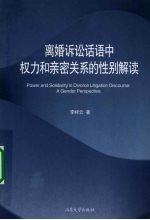

离婚诉讼话语中权力和亲密关系的性别解读PDF电子书下载
- 电子书积分:12 积分如何计算积分?
- 作 者:李祥云著
- 出 版 社:济南:山东大学出版社
- 出版年份:2009
- ISBN:9787560739113
- 页数:301 页
Chapter 1 Introduction 1
1.1 Rationales for the present research 1
1.1.1 Theoretical rationale 1
1.1.2 Practical rationale 4
1.2 Research questions 5
1.3 Methodology of the present research 6
1.3.1 Data collection 6
1.3.2 Transcription of the data 8
1.3.3 Calculation and interpretation of the results 9
1.4 Organization of the book 9
Chapter 2 Literature Review:Two Main Social Approaches 11
2.1 Introduction 11
2.2 Related law issues in China 11
2.2.1 Inquisitorial system 11
2.2.2 Trial procedures 13
2.2.3 Mediation 14
2.3 Forensic linguistics 20
2.3.1 Forensic linguistics abroad 21
2.3.2 Forensic linguistics in China 24
2.4 Power and forensic linguistics 25
2.4.1 Power:A social perspective 25
2.4.2 Power:A linguistic perspective 29
2.4.3 Power in forensic linguistics 36
2.5 Gender and language 46
2.5.1 Sex and gender 46
2.5.2 Men and women in society 47
2.5.3 Linguistic studies on gender 53
2.6 Summary 61
Chapter 3 Relevant Linguistic Theories and the Analytical Framework 63
3.1 Introduction 63
3.2 Critical discourse analysis 64
3.2.1 Feminist critical discourse analysis 66
3.2.2 Fairclough's three-level model 69
3.3 Systemic functional linguistics 72
3.3.1 Language as a social semiotic system:Key tenets of SFL 73
3.3.2 Systemic functional linguistics in critical discourse analysis 79
3.4 Appraisal theory 81
3.5 Conversation analysis 87
3.6 The analytical framework 90
3.7 Summary 94
Chapter 4 Power and Solidarity in Court:The Lexicogrammatical Level 96
4.1 Introduction 96
4.2 Power and solidarity 97
4.2.1 Power and solidarity in court 101
4.2.2 Power in marriage 105
4.2.3 Power comparisons in twelve cases 110
4.3 Appraisal elements in court discourse 123
4.3.1 Affect 124
4.3.2 Engagement and deontic modality 143
4.3.3 Graduation 157
4.4 Summary 168
Chapter 5 Power and Solidarity in Court:The Textual Level 172
5.1 Introduction 172
5.2 Speech turns 173
5.2.1 Men and women's total turns in court 177
5.2.2 Turn-taking without the judge's permission 180
5.2.3 Dispreferred turns 189
5.3 Interruptions 197
5.3.1 Interruptions in court 200
5.3.2 Interpretation 218
5.4 Overlap 219
5.5 Topic initiation/change 222
5.6 Utterances inviting judges' involvement 227
5.7 Summary 233
Chapter 6 Reflected Prejudicing Ideologies in Court 240
6.1 Introduction 240
6.2 Ideology 241
6.3 Women's self-depictions 242
6.4 The judge's bias 249
6.5 Summary 253
Chapter 7 Conclusion 254
7.1 Major findings and suggestions 254
7.2 Major contributions 261
7.3 Limitations and further studies 263
Appendices 266
References 278
- 《当代翻译美学的理论诠释与应用解读》宁建庚著 2019
- 《白纻舞及其歌辞的文化解读》王俊,曹化根著 2019
- 《你的话语是我沉默中开出的花朵》(法)安东尼·帕耶著 2019
- 《名家解读经典系列 王季思推荐古代戏曲》王季思 2017
- 《改革进程中的刑事诉讼程序与证据问题研究 基于警察的视角》谢波 2019
- 《近代以来中国大众话语的生成与流变》罗崇宏著 2019
- 《在生活中养生 《中国公民中医养生保健素养》解读》吕沛宛,侯江红 2019
- 《现代南方民族文学话语研究》(中国)吴道毅 2019
- 《危险化学品企业安全风险隐患排查治理导则解读》中国化学品安全协会 2019
- 《中国关键词 19大篇 汉英对照 2 权威解读当代中国》中国外文出版发行事业局,当代中国与世界研究院,中国翻译研究院著 2018
- 《中风偏瘫 脑萎缩 痴呆 最新治疗原则与方法》孙作东著 2004
- 《水面舰艇编队作战运筹分析》谭安胜著 2009
- 《王蒙文集 新版 35 评点《红楼梦》 上》王蒙著 2020
- 《TED说话的力量 世界优秀演讲者的口才秘诀》(坦桑)阿卡什·P.卡里亚著 2019
- 《燕堂夜话》蒋忠和著 2019
- 《经久》静水边著 2019
- 《魔法销售台词》(美)埃尔默·惠勒著 2019
- 《微表情密码》(波)卡西亚·韦佐夫斯基,(波)帕特里克·韦佐夫斯基著 2019
- 《看书琐记与作文秘诀》鲁迅著 2019
- 《酒国》莫言著 2019
